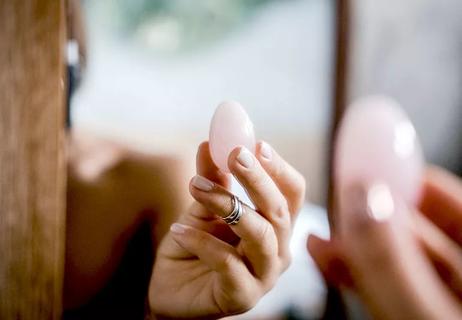Working your pelvic floor muscles can help you prevent and recover from urinary incontinence

Your prostate lives in your pelvic floor, a region that’s densely populated with different kinds of muscles, tissues and reproductive organs. When you have prostate surgery or a prostatectomy to have your prostate removed, it can sometimes lead to unwanted side effects that include urinary leakage, or incontinence, and erectile dysfunction.
Advertisement
Cleveland Clinic is a non-profit academic medical center. Advertising on our site helps support our mission. We do not endorse non-Cleveland Clinic products or services. Policy
But by focusing on general fitness and strengthening your pelvic musculature before and after surgery, you can reduce the severity or likelihood of those side effects happening and help foster a faster recovery time.
Physical therapists Melissa Dubrow, PT, DPT, and Jill Dubbs, PT, DPT, explain how pelvic floor exercises can help with your recovery, along with instructions on how to do them and common mistakes to avoid.
Recovery after prostate surgery isn’t unlike recovery from other surgical procedures. Everyone handles surgical procedures differently, and healing often takes time. But there are things you can do to help prepare your body before having a prostatectomy and things you can do to help your recovery after surgery.
“Most people know that after a total knee replacement, people need physical therapy to get back full function of their knee,” says Dr. Dubrow. “The same goes with your pelvic floor.”
Kegel exercises (pelvic floor exercises) aren’t just for women and people assigned female at birth (AFAB). People who have prostates can do Kegel exercises to help strengthen their pelvic floor muscles, stop urinary incontinence and help with erectile dysfunction. And in nearly all cases, both of these are treatable side effects regardless if you’ve had advanced prostate cancer.
Advertisement
“Even though surgeons do nerve-sparing surgeries, the nerves in your pelvic floor are a bit in shock after surgery and it takes them a while to wake up and regenerate,” explains Dr. Dubbs. “One important thing that people can do is work these muscles to bulk them up a bit so they help with continence and eventually erectile dysfunction, too.”
Sometimes, you might experience a weakening of your urethral sphincter muscles that help control the flow of urination and help hold urine (pee) in. That’s because urine has to travel through several valves in order to go from your kidneys to your bladder and out of your urethra, and one such valve may be removed in addition to your prostate or damaged during a prostatectomy.
People who’ve had a prostatectomy might initially experience constant leaking of urine, or a specific kind of urinary incontinence called stress incontinence, where you might leak urine when you cough, sneeze, lift something heavy, get up, sit down or do other physical activities. This typically happens because there’s too much stress or pressure on your bladder without a necessary, functioning valve to hold it back.
About 6% to 8% of people with prostates experience this kind of urinary leakage. But by strengthening and tightening your pelvic floor muscles around your bladder, you can help reduce the amount of pee that leaks or stop it from happening completely in mild to moderate cases of urinary incontinence.
“A lot of times, people will have incontinence issues after surgery and we need to build those muscles back up, as well as the sphincter muscles,” notes Dr. Dubrow. “Nowadays, urinary leakage is often temporary and you can recover that by doing pelvic floor exercises.”
Sometimes, a surgeon will remove all or part of a nerve that allows for erections to occur as part of a prostatectomy. This, along with other treatments like radiation or chemotherapy, could lead to temporary or permanent erectile dysfunction. And even when all of your nerves are intact, you may not get full functionality of your erection for at least six months to up to two years after surgery.
“You might not be getting spontaneous erections like you normally would, and you want that blood flow back in the penis,” states Dr. Dubrow. “We encourage using penis pumps or vacuum pumps for getting blood flow to the area and helping with erections as early as 10 days after having surgery. But Kegel exercises can help increase blood flow and strength to the area, too.”
People can begin doing Kegel exercises in the weeks or months leading up to their procedure and can start them up again after their catheter has been removed, about a week after surgery. But it’s important to remember that everyone heals differently.
Advertisement
Before doing Kegels, you should consult with your healthcare provider, urologist or pelvic health physical therapist who can evaluate the strength of your pelvic muscles. Your healthcare provider will teach you how often to perform the pelvic exercises correctly. One reason you want to do this before starting them on your own is that it’s possible for you to over-exercise your pelvic floor muscles.
“Sometimes, if people over-exercise their pelvic floor muscles or they’re really intense about it, they can get pelvic pain or their muscles become so tight they have trouble having a bowel movement because they can no longer relax and let that area open up,” warns Dr. Dubbs. “You should be able to flex those muscles and let go of those muscles really easily just like you can move your biceps really easily.”
The steps for doing pelvic floor exercises are relatively simple if you know how to find the muscles you’re looking to strengthen, flex and relax.
“Think about stopping urine mid-stream or as if you’re retracting your penis and making it smaller,” instructs Dr. Dubbs. “Another way to think about it is to think about pulling your ‘nuts to your guts,’ or your testicles toward your belly button.”
Advertisement
Once you understand the exercise, you can do Kegels anywhere, even from a sitting or lying down position. But the standing position is preferred by most pelvic health physical therapists because standing is a functional position and a bit more of a challenge.
Your healthcare provider will likely prescribe a combination of quick- and long-hold Kegels, in conjunction with a fitness routine, to maximize your recovery. Depending on the strength of your pelvic floor muscles, you may be prescribed alternating reps of these exercises multiple times a day until you regain continence.
“Not everyone can get there right away and that’s OK,” encourages Dr. Dubbs. “Sometimes, you have to start much slower because you can maybe only do a couple Kegels for a few seconds before your quality of contractions fall apart. But overall, you’ll want to do these until you gain continence or experience improvement in your erections.”
Doing Kegels can feel like a strange experience at first, but they’ve been proven to help over time. Perhaps the most common misconception about Kegels is understanding how it should feel, knowing that you’re flexing the right muscles and what you should be doing while performing Kegels. In other words, if you’re doing Kegels correctly, you shouldn’t be squeezing your gluteal muscles or inner thighs together and no one should be able to tell that you’re doing them.
Advertisement
“One of the things people tend to do is hold their breath and you should be breathing normally for each contraction,” says Dr. Dubbs. “If you hold your breath, it could increase your intrabdominal pressure and you might leak more urine because it puts more pressure on your bladder.”
You also want to avoid cycling, squatting or doing anything that puts intense pressure on your pelvic floor region for at least the first months after surgery. If you’re wondering when you can start doing these activities again, your healthcare provider can help guide you based on your specific situation.
“It will heal, it just depends on the surgeon’s protocol and how you’re feeling,” says Dr. Dubbs. “The important thing to focus on is making sure you’re out doing the thing you love and getting enough exercise and health benefits from those exercises.”
And that’s the key: While there are many other solutions for treating the side effects of prostate cancer treatments, there are a variety of other benefits to be had from simply having a regular routine of cardio exercises, strength training and other workouts that not only improve your pelvic health, but also focus on your overall health and wellness.
“Most days of the week, you want to keep up with Kegels, along with good general fitness, cardio and weightlifting,” advises Dr. Dubbs. “The more in shape you are, the better you’ll do with your continence.”
Learn more about our editorial process.
Advertisement

Endometriosis, pelvic floor dysfunction and bladder issues can all contribute, but relief is within reach

Manage your sexual health and urinary function with annual appointments starting at age 40

A prostate massage is used most often for sexual stimulation

Foods that can help, and harm, your prostate

Here’s the truth about these egg-shaped crystals, straight from the experts

A Kegel routine will get your pelvic floor muscles in top shape

Type 2 diabetes isn’t inevitable with these dietary changes

Applying a hot or cold compress can help with pain